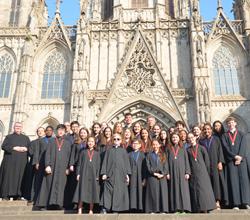
The Choir of Grace Church, New York, New York, toured Spain June 16–24, singing at San Lorenzo de El Escorial, Mezquita-Iglesia de El Salvador, Toledo, La Santa Iglesia Catedral, Consagrada a la Virgen María en su Asunción a los cielos, Toledo, Iglesia de San Manuel y San Benito, Madrid, Basilica del Pilar, Zaragoza, Santa Maria de Montserrat Abbey, Catedral de la Santa Creu i Santa Eulàlia, Barcelona, and Basílica i Temple Expiatori de la Sagrada Família, Barcelona.
The musical offerings of the tour comprised full concerts, shorter choral meditations, and singing during Mass. Twenty-six treble choristers from the Choir of Men and Boys and the Girls’ Choir joined together with the ATB singers that support both treble groups for the tour. Selections by Beethoven, Burleigh, Byrd, Duruflé, Mozart, Palestrina, Barry Rose, Stainer, Stanford, Tallis, and others were presented. Patrick Allen is organist and master of choristers.
For information: www.gracechurchnyc.org.

